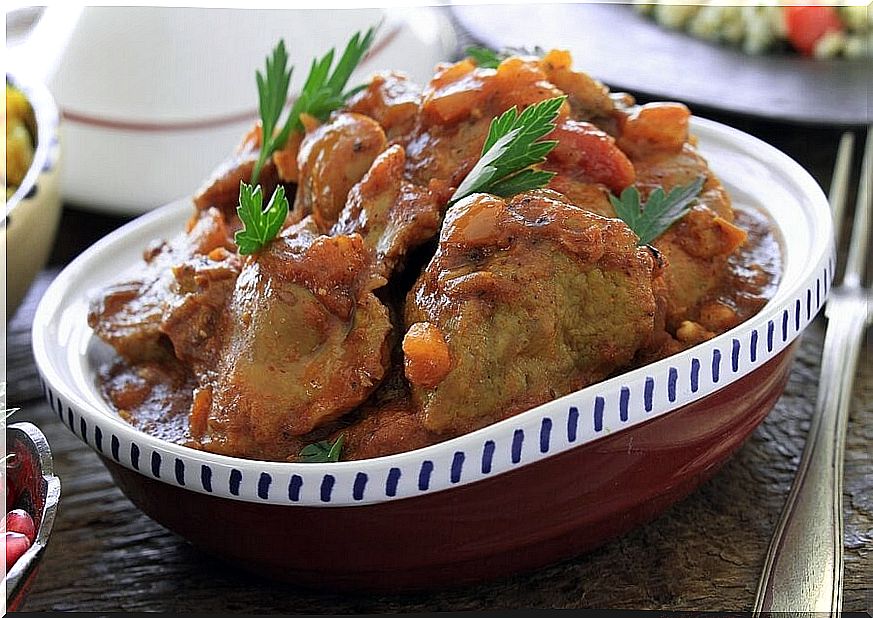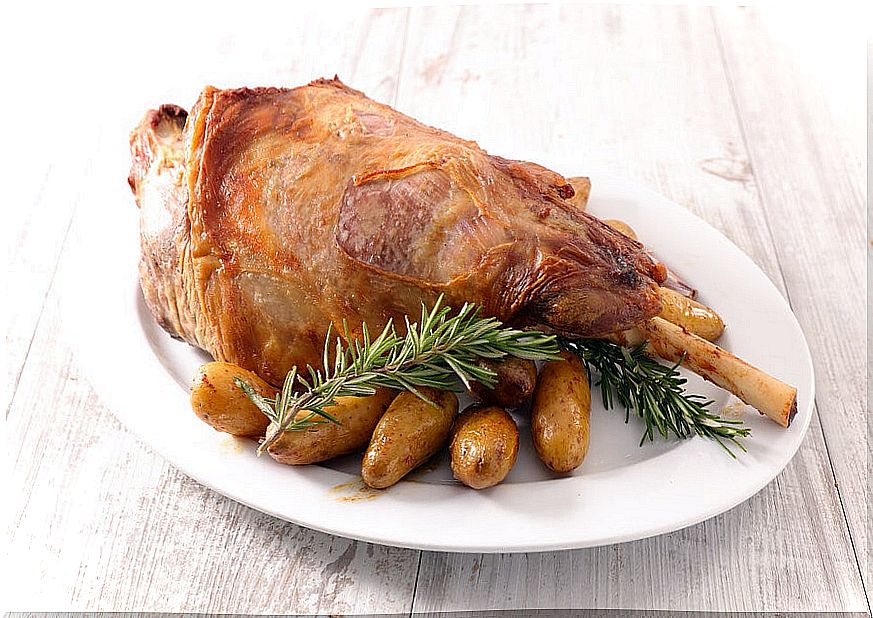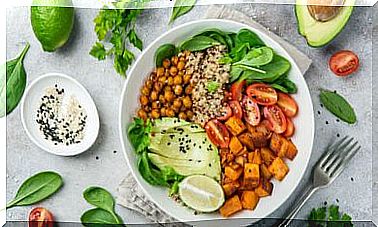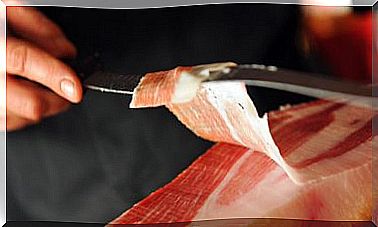Lamb Meat: Nutritional Values, Benefits And Contraindications
Lamb meat is highly appreciated by some, but completely unknown to others. Many people wonder if lamb meat is healthy. And the truth is that consumed in moderation it can be part of a healthy diet without any problem.
Its nutritional value is interesting due to the contribution of minerals and proteins of high biological value. In the following article, we point out all its benefits and how to integrate it into the dietary guideline.
Lamb meat in gastronomy

The lamb is the baby of the sheep ( Ovis aries ) that is slaughtered before it is one year old. Its meat is classified into different types according to the age of the animal. This can also influence the organoleptic quality and the final nutritional value.
The most appreciated is the suckling lamb. It is an animal that has not yet been weaned and from which a much more tender meat with a delicate flavor is obtained. It has a white hue (compared to older animals that are more pink) and a lower proportion of fat.
The consumption of lamb meat is traditional in some parts of the world such as the Maghreb, India, Iran or Spain. It is prepared, as a general rule, in the form of stews such as tajín or roasts in the oven. It is also usually a food most consumed at some times of the year such as Christmas or Easter.
It is a meat with a great flavor, very easy to digest and that provides a moderate amount of energy. Therefore, it can be taken at any age and does not have to be eliminated from weight loss diets.
Nutritional values of elder meat
The nutritional composition of lamb meat is, in general, similar to that of other meats with some specific exceptions . 100 grams of edible product provide the following macronutrients:
- 240 calories.
- 17.9 grams of protein.
- 0 grams of carbohydrates.
- 0 grams of fiber.
- 18.7 grams of fat.
- 78 milligrams of cholesterol.
Regarding the lipid content, it is convenient to know that the amount of fat present varies according to the age of the animal and the part consumed. Thus, the younger the lamb, the lower the presence of lipids. The stick chops are the parts with a higher proportion, while the leg contains more or less half.
At the micronutritional level, lamb meat provides a good number of vitamins and minerals, some of which are difficult to obtain from other food sources.
Iron
One of the most prominent minerals in red meat is heme iron, its most bioavailable form and best absorbed by the body. This is vital in all living organisms because it participates in processes such as the transport of oxygen and electrons or the synthesis of DNA.
Zinc
Zinc is essential for the formation of hormones such as testosterone or insulin. In addition, it plays an important role in different functions such as reproduction, immunity and healing.
Selenium
It is a trace element that is not usually taken into account. However, it is essential for some functions such as reproduction, thyroid hormone metabolism, and DNA synthesis.
In addition, it protects against infections and oxidative damage. Its main food source is fish and organ meats, but it is also found in the muscular parts of animals.
Match
Another mineral that is present in all cells of the body. Much of it in the teeth and bones. The body needs it to carry out some of its daily chemical processes. As observed in its nutritional composition, one serving provides about 40% of the adequate phosphorus intake for adults.
B12 vitamin.
It is an important nutrient for blood formation and brain development. Its deficit can cause anemia and neurological damage, a situation that can be serious if it is not reversed. It should be noted that cobalamin (or B12) can only be obtained from products of animal origin.
Niacin or vitamin B3.
Niacin is necessary to convert eaten food into energy available to the body. Although it is not very common, its deficit can cause problems such as depression, headaches, extreme tiredness, apathy or memory loss.
What are the health benefits?

A moderate consumption of fresh lamb meat cooked at a low temperature, without direct contact with fire, and eaten in moderation is safe and healthy. It can even be positive in the following ways.
Contribution of proteins of high biological value
One of the main nutritional characteristics of lamb is the presence of protein in approximately 18% of its weight. These are considered of high biological value, which means that they have all the essential amino acids that the body needs.
Proteins are required for normal development and function. They are part of many structures such as hair, muscles, blood cells or enzymes. In addition, they are necessary for proper coagulation and optimal functioning of the immune system, the transport of substances or the transmission of nerve impulses.
Eating lamb and other protein sources is especially beneficial for recovering athletes, bodybuilders, or people who have undergone surgery.
Improved physical performance
As mentioned in the previous section, protein intake is essential for good physical performance. On the other hand, it can also benefit from the presence of a specific amino acid present in lamb: beta-alanine.
From this, the body makes carnosine. In some studies it has been observed that high amounts in muscle are associated with less fatigue and better results during exercise.
Decreased incidence of iron deficiency anemia
As experts point out, iron deficiency anemia is one of the most common types of anemia and is caused by low levels of iron in the body. As a result, the red blood cells responsible for transporting oxygen to the cells cannot be formed. Therefore, its main symptoms are fatigue and weakness.
The body absorbs this mineral best when it comes from meat and other sources of heme iron. In addition, it helps to assimilate the plant origin. This is of special interest in risk groups such as pregnant women, women with heavy periods, infants and infants, and people who donate blood frequently.
Help for the immune system
One of the elements that you get from eating meat is zinc. Increasing its consumption is positive to improve the defense system. As a study published in the journal Molecular and Cell Biochemistry indicates, ” People who are deficient in zinc may experience increased susceptibility to a wide variety of pathogens.”
The key points to consume lamb meat in a healthy way
In the culinary imagination, the intake of this type of meat is closely related to some celebrations and great meals. However, it is also a good option to eat on a day-to-day basis.
The Spanish Association of Pediatrics considers it as one of the meats to be introduced in children during food supplementation, more or less from 8 or 9 months of age once leaner meats such as chicken or turkey have been accepted. The amounts should be appropriate for the baby’s age.
As it is a meat classified within the group of red meat, its intake should be moderate but not prohibited. Expert recommendations are to include a maximum weekly serving of unprocessed red meat such as lamb, beef, or pork.
Some observational studies link saturated fat and cholesterol in this type of meat as a cardiovascular risk factor and for some types of cancer. To this day, these statements are questioned by some professionals since direct causality cannot be affirmed.
Despite these doubts, for the moment it is best not to abuse them. Likewise, it is necessary to choose it in its fresh form and avoid all processed products of both red and lean meat.
Lamb meat can be easily bought at any local market. If it’s local, grass-fed, and low-fat, so much the better. Although the latter can also be removed a little at home before cooking.
It accepts many types of cooking such as roasted in the oven or stewed in the casserole. It can be accompanied by vegetables such as tomato, leek, carrot or onion; or potatoes and other tubers.







